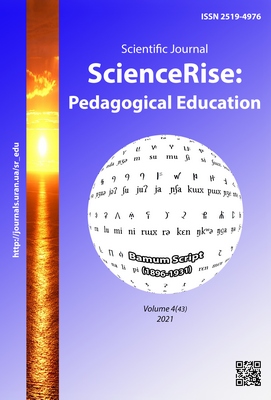Моделювання фізичних явищ як методичний засіб формування структури знань з фізики та програмування
DOI:
https://doi.org/10.15587/2519-4984.2021.237974Ключові слова:
методика навчання фізики, ментальні, матеріалізовані дії, ієрархія, еволюція структури знаньАнотація
З метою підведення теоретичної бази під час вдосконалення методик проведення лабораторних робіт з фізики та з програмування проведено дослідження психологічних пізнавальних (когнітивних) процесів, що супроводжують відповідну навчальну діяльність. Важливим моментом роботи є дослідження ментальної сторони навчальних дій в термінах формальної логіки. Розглянуті супутні цим ментальним діям матеріалізовані кроки та мовна активність. Змістовна складова мовної активності розглянута в роботі, як важливий діагностичний фактор, що вказує на рівень розуміння сутності нового матеріалу або завершеності відповідної пізнавальної структури. Представлені оригінальні графічні способи формалізації пізнавальної схеми об'єкту діяльності й логіки її формування в контексті ментальних і матеріалізованих навчальних дій. Ці уявлення були застосовані для розгляду процесу навчальної діяльності на прикладі складання простої фізичної моделі, що реалізовувалась мовою Python за допомогою бібліотеки Visual. Навчальні дії розглядались через призму еволюції структурної організації ментального відображення об’єктів цієї діяльності.
У роботі було зафіксовано циклічний характер відповідних пізнавальних процесів, матеріалізованих дій та ієрархічний характер структури знань, що формується в процесі навчальних дій з фізики та з програмування. Здійснено співвіднесення цих процесів з динамікою еволюції структури знань. Сформульовані концептуальні ідеї, які могли б бути корисними для модифікацій методик проведення лабораторних занять в напрямку моделювання процесів і явищ фізики. Окремі алгоритмічні задачі на моделювання фізичних процесів розглядаються в роботі, як компоненти цілісної системи задач. На думку авторів, при підготовці висококваліфікованих фахівців в природничих науках необхідно значний час приділяти усвідомленому цілеспрямованому формуванню протоколів абстрактно-логічного, причинно-наслідкового мислення. Методологія такої роботи добре формалізована, зокрема, у відомих методах низхідної покрокової деталізації та у модульному програмуванні
Посилання
- Kholodnaya, M. A. (2019). Psikhologiya intellekta: paradoksy issledovaniya. Moscow: Yurayt, 334.
- Chuprikova, N. I. (Ed.) (2014). Differentsionno-integratsionnaya teoriya razvitiya. Moscow: Yazyki slavyanskoy kultury, 720.
- Holovin, M., Holovina, N., Holovina, N. (2018). Computer Modeling of Physical Processes and Specifics of Relevant Educational Activities. Psychological Prospects Journal, 31, 57–70. doi: http://doi.org/10.29038/2227-1376-2018-31-57-70
- Mayer, R. V. (2015). Kompyuternoe modelirovanie. Glazov: GGPI, 620.
- Miller, G. A. (1956). The magical number seven, plus or minus two: Some limits on our capacity for processing information. Psychological Review, 63 (2), 81–97. doi: http://doi.org/10.1037/h0043158
- Ivanova, G. S. (2016). Tekhnologiya programmirovaniya. Moscow: KNORUS, 334.
- Getmanova, E. E. (2005). Ispolzovanie Visual Python dlya modelirovaniya fizicheskikh protsessov. Kompyuternye instrumenty v obrazovanii, 4, 43–47.
- Windsor, M. A., English, L. Q. (2019). VPython for Introductory Mechanics: Complete Version. VPython for Introductory Mechanics. Available at: https://scholar.dickinson.edu/vpythonphysics/1
- Podolskiy, A. I. (2017). Nauchnoe nasledie P. Ya. Galperina i vyzovy XXI veka. Natsionalniy psikhologicheskiy zhurnal, 3 (27), 9–20.
- Holovin, M. B. (2008). Rozumovi ta materilizovani dii, yikh verbalne suprovodzhennia v konteksti praktychnoho navchalnoho prohramuvannia. Visnyk cherkaskoho universytetu. Pedahohichni nauky, 136, 7–13. Available at: http://evnuir.vnu.edu.ua/handle/123456789/12867
##submission.downloads##
Опубліковано
Як цитувати
Номер
Розділ
Ліцензія
Авторське право (c) 2021 Nina Holovina, Mykola Holovin

Ця робота ліцензується відповідно до Creative Commons Attribution 4.0 International License.
Наше видання використовує положення про авторські права Creative Commons CC BY для журналів відкритого доступу.
Автори, які публікуються у цьому журналі, погоджуються з наступними умовами:
1. Автори залишають за собою право на авторство своєї роботи та передають журналу право першої публікації цієї роботи на умовах ліцензії Creative Commons CC BY, котра дозволяє іншим особам вільно розповсюджувати опубліковану роботу з обов'язковим посиланням на авторів оригінальної роботи та першу публікацію роботи у цьому журналі.
2. Автори мають право укладати самостійні додаткові угоди щодо неексклюзивного розповсюдження роботи у тому вигляді, в якому вона була опублікована цим журналом (наприклад, розміщувати роботу в електронному сховищі установи або публікувати у складі монографії), за умови збереження посилання на першу публікацію роботи у цьому журналі.









